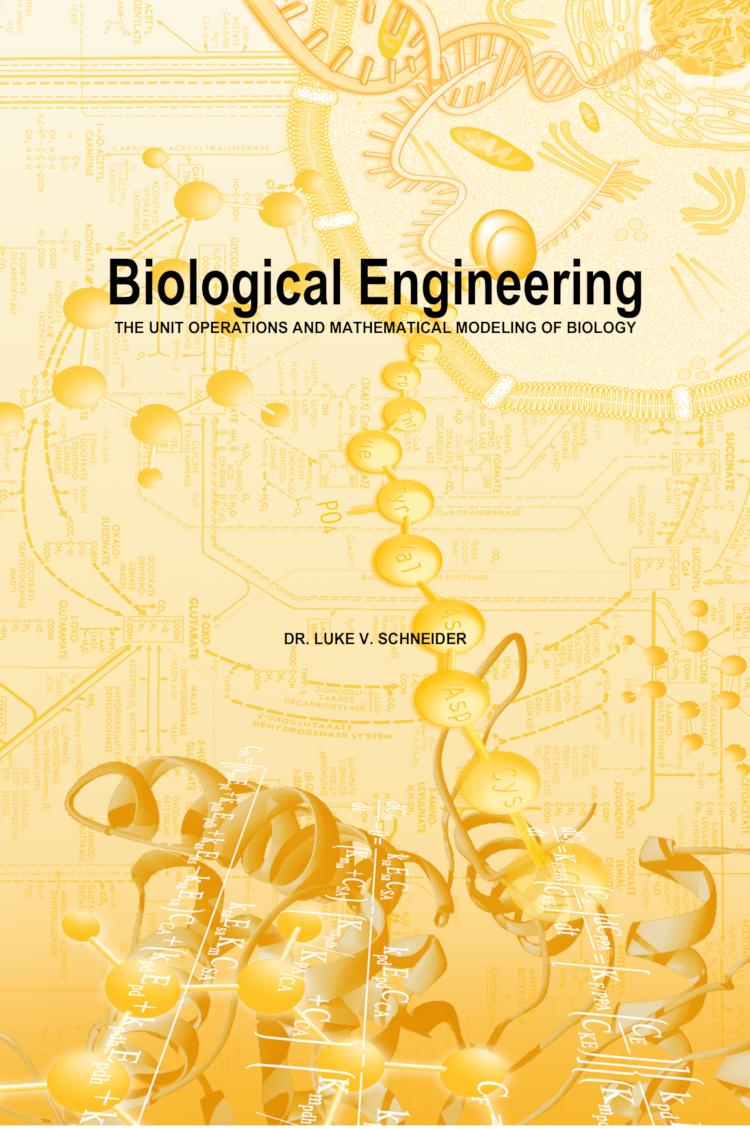
Biological Engineering
The Unit Operations and Mathematical Modeling of Biology
by Dr. Luke V. Schneider
This book is intended as a 4th year or graduate studies text for coursework in biological engineering. Biological engineering is distinct from biochemical engineering in that the biological engineer seeks to apply engineering principles to understand what goes on inside the living cell that the biochemical engineer treats as a black box. It is assumed that the student will have had introductory courses in cell biology, biochemistry, chemical kinetics, and thermodynamics. This book is meant as an adjunct course of study to those with a biochemical engineering background. The initial four chapters of this text are written by way of reference and review of the information that would have been provided the student in these prerequisite courses. Later chapters are dedicated to membrane transport, metabolic engineering, genetic regulation, and signal transduction models.
Table of Contents
CHAPTER 1: INTRODUCTION
1.1.The Evolution of Biology as a Science
1.2.The Scientific Method
1.3.A Historical Perspective on Biological Models
1.4.A Unit Operations Approach
1.5.Biological Engineering
1.6.Model Representations
1.7.Qualitative vs. Quantitative Solutions
CHAPTER 2: BALANCE AND TRANSPORT EQUATIONS
2.1.The Control Volume
2.2.Balance Equations
2.3.Application to Biological Systems
CHAPTER 3: THE CELL AND CELLULAR COMPOSITION
3.1.Cell Biology
3.2.Cellular Biochemistry
3.3.Major Biochemical Components
3.4.Macromolecular Composition Changes
3.5.Cell Membrane
3.6.Life is So Complex Why do We Try to Model It?
CHAPTER 4: THERMODYNAMICS OF LIFE
4.1.Basic Thermodynamics
4.2.Origins of Life
4.3.Catabolic Metabolism
4.4.Proton Motive Force (PMF)
4.5.Anabolic Metabolism
4.6.Culture Media Design
4.7.C, N, S, O Cycles
CHAPTER 5: MICROBIAL GROWTH AND DEATH
5.1.Cell Growth
5.2.Growth Stoichiometry
5.3.Batch Culture
5.4.Fed-Batch Culture
5.5.Chemostats
5.6.Immobilized Cell Reactor
5.7.Photobioreactors
CHAPTER 6: CHEMICAL KINETICS AND ENZYMOLOGY
6.1.Chemical Equilibria
6.2.Binding Reactions
6.3.Enzyme Kinetics
6.4.Higher Order Enzymatic Reactions
6.5.Regulation of Enzyme Activity
6.6.Effects of Reaction conditions on Enzyme Activity
CHAPTER 7: MEMBRANE TRANSPORT
7.1.Biological Membranes
7.2.Diffusional Transport
7.2.1.Diffusion to the Membrane
7.3.Porins (Channel Proteins)
7.4.Facilitated Diffusion
7.5.Active Transport
7.6.Relationship between Transport and Cell Growth
CHAPTER 8: METABOLIC ENGINEERING
8.1.Metabolic Networks
8.2.Metabolic Engineering
8.3.Metabolic Engineering of Phenylalanine BioSynthesis
8.4Compartmental Models
8.5.Metabolic Engineering of a Chemostat Fermentation
CHAPTER 9: NUCLEIC ACIDS AND GENES
9.1.Nucleotide Bases
9.2.The Double Helix
9.3.The Genetic Code
9.4.Hybridization
9.5.Translation
9.6.Transcription
9.7.Genes
CHAPTER 10: GENETIC REGULATION MODELS
10.1.Regulation of Gene Expression
10.2.Gene Expression Models
10.3.Amplification of Gene Expression
10.4.Response Attenuation
CHAPTER 11: CASE STUDY—LAC OPERON OF ESCHERICHIA COLI
11.1.Material Balance Equations
11.2.Phenomenological Equati
11.3.Solution
CHAPTER 12: CASE STUDY—HUT OPERON OF BACILLUS SUBTILIS
12.1.Histidine Metabolism
12.2.Model for HutP Expression
12.3.Model For HutHUIGM Expression
12.4.Dimensionless Formulation
12.5.Solutions of the Dimensionless Hut Operon Model
CHAPTER 13: CASE STUDY—HPK/RR SYSTEMS
13.1.The Pho Regulon
13.2.HPK/RR Regulatory System Model
13.3.Model for Pho Gene Expression
13.4.Empirical Validation of the Model
13.5.Signal Transduction
CHAPTER 14: SIGNAL TRANSDUCTION WITH G PROTEIN COUPLED RECEPTORS
14.1. Definition of Signal Transduction
14.2.GPCR Signal Transduction Model (Olfaction)
14.3.Signal Amplification
APPENDIX A: BALANCE EQUATIONS
APPENDIX B: BIOCHEMICAL THERMODYNAMICS
(C) 2021, LVS Sciences, LLC. All rights reserved.
LVS Sciences, LLC
1321 Upland Dr. Suite
Houston, TX 77043
United States of America.